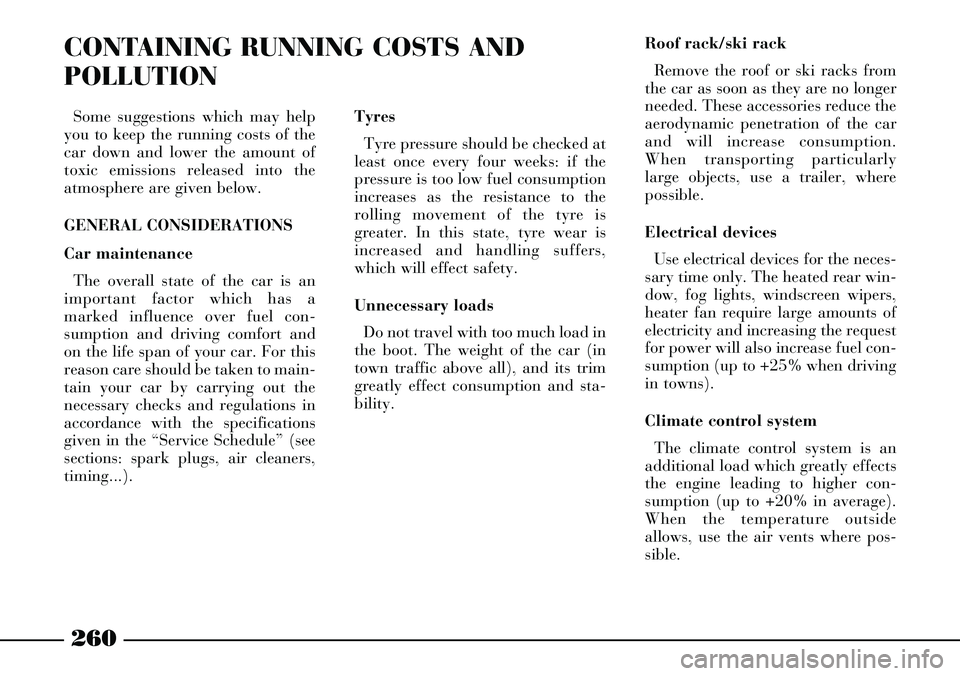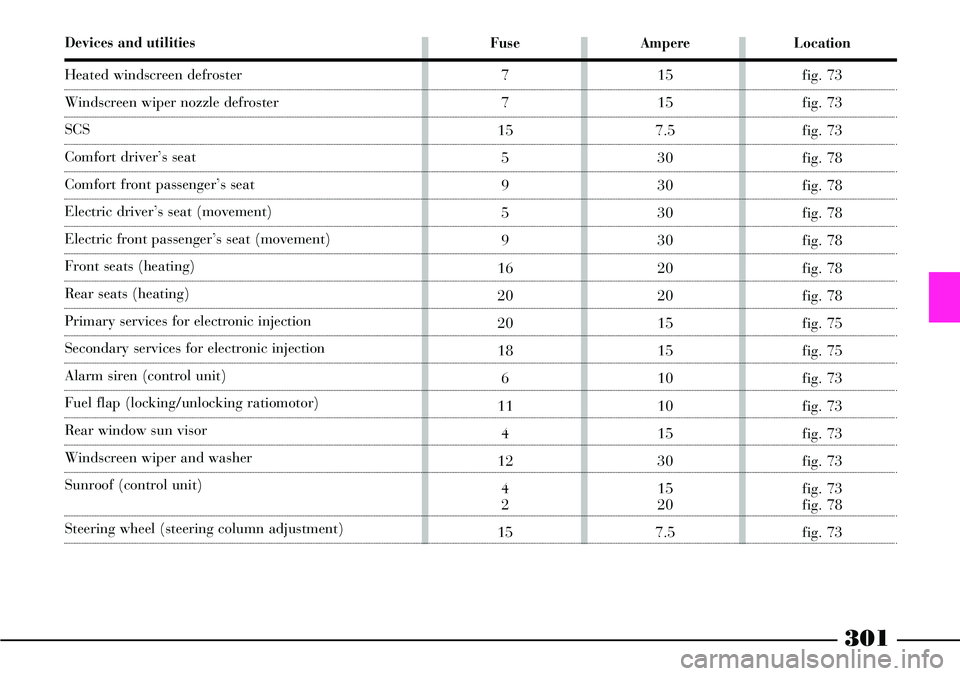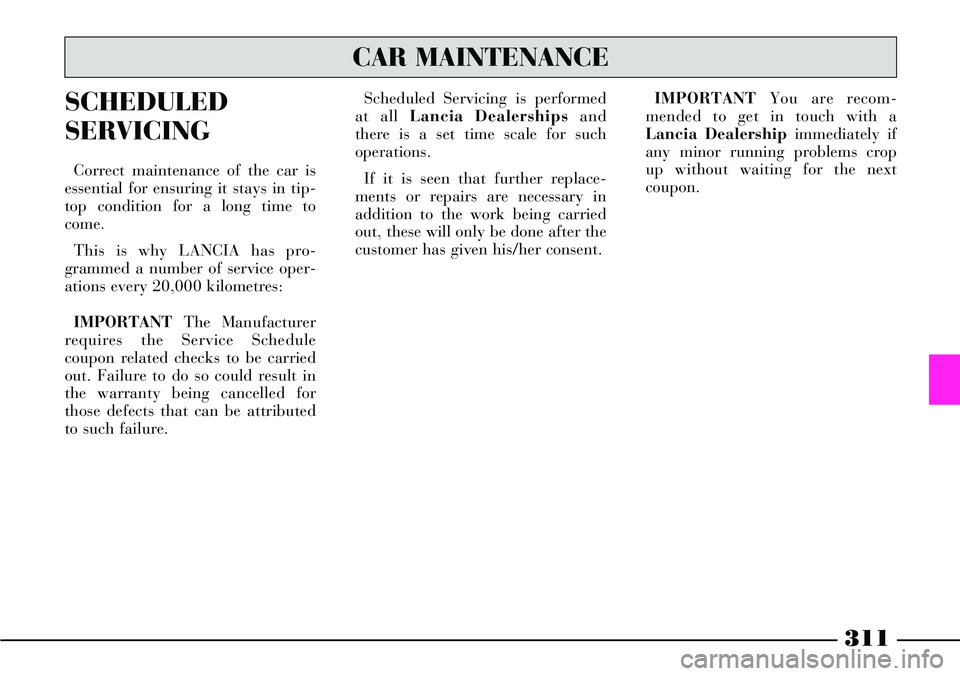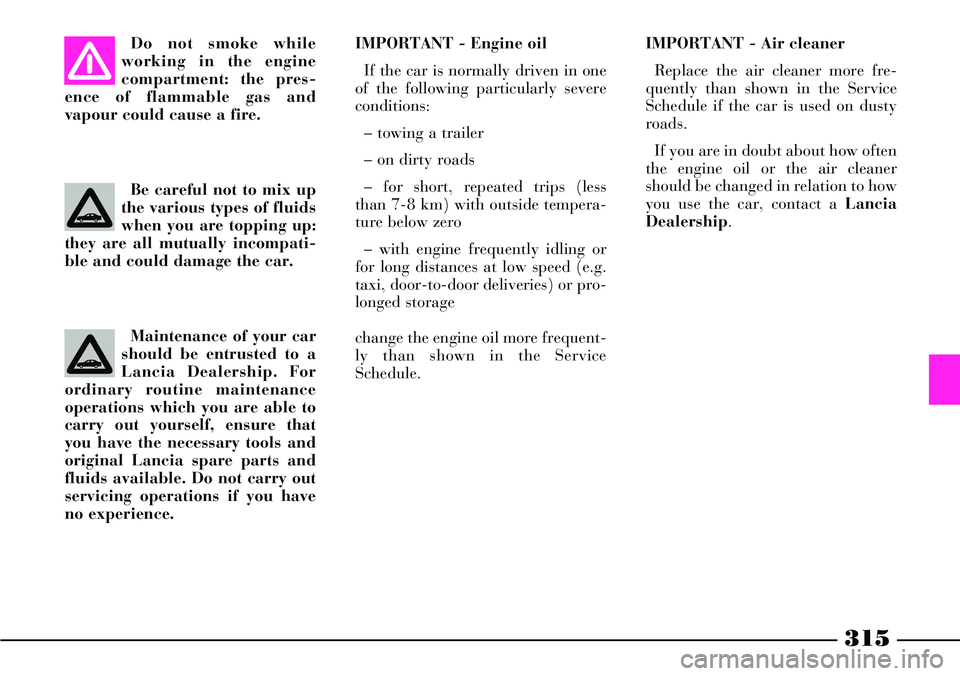service Lancia Thesis 2007 Owner handbook (in English)
[x] Cancel search | Manufacturer: LANCIA, Model Year: 2007, Model line: Thesis, Model: Lancia Thesis 2007Pages: 386, PDF Size: 8.69 MB
Page 178 of 386

177
“Automatic parking brake” function
and the press “OK”. Deactivation of
automatic operation can be achieved
also in the following way:
– turn the key to STOP(the park-
ing brake is engaged)
– turn the key back to MAR,
depress the brake pedal and at the
same time keep button Apressed for
at least 2 seconds. Warning light x
flashes thrice to indicate the auto-
matic operation deactivation.
When the key is turned again to
STOPthe parking brake will not be
engaged. The parking brake auto-
matic operation will be automatical-
ly restored when the key is turned
again to MAR.IMPORTANTIf, after the parking
brake has been disengaged, the car
starts moving at a speed higher than
the usual manual movement, deacti-
vation of the automatic mode is
immediately cancelled and the park-
ing brake is engaged.
If, after the parking
brake has been disen-
gaged, the car starts mov-
ing at a speed higher than the
usual manual movement, deacti-
vation of the automatic mode is
immediately cancelled and the
parking brake is engaged.Proceed as follows: release the
accelerator pedal, press and keep
button A(fig. 133) pressed for the
whole manoeuvre: the system elec-
tronic control unit will come imme-
diately into action with alternate
braking on/off cycles on the rear
wheels (thus preventing wheel lock-
ing). Braking cycles are applied
alternately on right and left wheel to
guarantee roadholding, braking
continuity and to reduce braking
distance.
Wheel locking could take place
under the safety speed threshold
(lower than 10 km/h).
A buzzer will sound during the
whole manoeuvre to indicate that
the dynamic mode shall only be used
in an emergency, but this is also use-
ful to warn the driver if the parking
brake has been inadvertently
engaged by other passengers.
Use in an emergency
In particular cases (e.g. fault in the
whole hydraulic brake system, both
service and emergency brake), the
parking brake can be used to stop
the car running (“dynamic mode”).
Page 240 of 386

239
In an emergency, the flap can be
released by pulling wire B(fig. 216)
on the right-hand side of the boot
inside the service compartment.
To open the compartment flap,
turn the catch C(fig. 217) to 1using
the ignition key and lower it.IMPORTANT The airtight seal of
the cap may lead to a slight increase
of pressure in the tank. A hissing
sound when the cap is removed is
therefore quite normal.
The cap is equipped with a device
which fastens it to the flap so that it
cannot be misplaced D(fig. 218).
While you are filling up, fasten the
cap to the device inside the flap as
shown in the figure.
Do not put naked flames
or lighted cigarettes near
the fuel filler hole as there
is a danger of fire. Do not bend too
close to the hole either so as not to
breathe in harmful vapours.REFUELLING
To guarantee full tank filling, carry
out two refuelling operations after the
first click of the fuel delivery gun. Avoid
further topping up operations that
could cause damages to the fuel system.
IMPORTANTRefuelling shall always
be performed with engine off and igni-
tion key to STOP. If the engine is off
but the key is to MAR, a wrong fuel
level could temporarily be indicated.
This is due to the internal system con-
trol logic and cannot be considered as
a system malfunctioning.
fig. 217
L0A0303b
fig. 218
L0A0014b
fig. 216
L0A0015b
Page 261 of 386

260
CONTAINING RUNNING COSTS AND
POLLUTION
Some suggestions which may help
you to keep the running costs of the
car down and lower the amount of
toxic emissions released into the
atmosphere are given below.
GENERAL CONSIDERATIONS
Car maintenance
The overall state of the car is an
important factor which has a
marked influence over fuel con-
sumption and driving comfort and
on the life span of your car. For this
reason care should be taken to main-
tain your car by carrying out the
necessary checks and regulations in
accordance with the specifications
given in the “Service Schedule” (see
sections: spark plugs, air cleaners,
timing...).Tyres
Tyre pressure should be checked at
least once every four weeks: if the
pressure is too low fuel consumption
increases as the resistance to the
rolling movement of the tyre is
greater. In this state, tyre wear is
increased and handling suffers,
which will effect safety.
Unnecessary loads
Do not travel with too much load in
the boot. The weight of the car (in
town traffic above all), and its trim
greatly effect consumption and sta-
bility.Roof rack/ski rack
Remove the roof or ski racks from
the car as soon as they are no longer
needed. These accessories reduce the
aerodynamic penetration of the car
and will increase consumption.
When transporting particularly
large objects, use a trailer, where
possible.
Electrical devices
Use electrical devices for the neces-
sary time only. The heated rear win-
dow, fog lights, windscreen wipers,
heater fan require large amounts of
electricity and increasing the request
for power will also increase fuel con-
sumption (up to +25% when driving
in towns).
Climate control system
The climate control system is an
additional load which greatly effects
the engine leading to higher con-
sumption (up to +20% in average).
When the temperature outside
allows, use the air vents where pos-
sible.
Page 263 of 386

262
Traffic and road conditions
Heavy traffic and higher consump-
tion are synonymous, for example
when driving slowly with frequent
use of lower gears or in towns where
there are numerous traffic lights.
Winding roads, mountain roads
and bumpy roads also have a nega-
tive effect on consumption.
Enforced halts
During prolonged stops (level
crossings, etc.) the engine should be
switched off.Environmental protection has been
one of the guiding principles in the
production of the THESIS.
It is not accident that its pollution
control equipment is much more
effective than that required by cur-
rent legislation.
Nonetheless, the environment can-
not get by without a concerted effort
from everyone.
By following a few simple rules you
can avoid harming the environment
and often cut down fuel consump-
tion at the same time. On this sub-
ject, a few useful tips have been
given below to supplement those
marked by symbol #, at various
points of the handbook.
You are asked to read both the for-
mer and the latter carefully.CHEAP RUNNING THAT RESPECTS THE
ENVIRONMENT
LOOKING AFTER EMISSION
CONTROL DEVICES
The correct use of pollution control
devices not only ensures respect for
the environment but also has an
effect on the car’s performance.
Keeping these devices in good condi-
tion is therefore a fundamental rule
for driving that is easy on your
pocket and on the environment too.
The first step is to follow the
“Service Schedule” to the letter.
Only use unleaded petrol for petrol
engines (95 RON), for JTD versions
only diesel fuel (EN590 specifica-
tion).
Page 296 of 386

295
The devices protected by the fuses
(fig. 75) are listed in the tables on
the following pages.
After replacing the fuses refit the
cover by refitting the fastening clips.FUSES IN THE BOOT
The fusebox (fig. 77) is located on
the right side of the boot, inside the
service compartment.
To open the compartment flap turn
the catch A(fig. 76) to 1with the
ignition key and lower it. The spare fuses, with different
amperage, are housed in vertical
position at the sides of the fusebox.
The devices protected by the fuses
(fig. 78) are listed in the tables on
the following pages.
fig. 75
L0A0267b
fig. 76
L0A0275b
fig. 77
L0A0146b
fig. 78
L0A0266b
Page 302 of 386

301
Devices and utilities
Heated windscreen defroster
Windscreen wiper nozzle defroster
SCS
Comfort driver’s seat
Comfort front passenger’s seat
Electric driver’s seat (movement)
Electric front passenger’s seat (movement)
Front seats (heating)
Rear seats (heating)
Primary services for electronic injection
Secondary services for electronic injection
Alarm siren (control unit)
Fuel flap (locking/unlocking ratiomotor)
Rear window sun visor
Windscreen wiper and washer
Sunroof (control unit)
Steering wheel (steering column adjustment)
Ampere
15
15
7.5
30
30
30
30
20
20
15
15
10
10
15
30
15
20
7.5
Location
fig. 73
fig. 73
fig. 73
fig. 78
fig. 78
fig. 78
fig. 78
fig. 78
fig. 78
fig. 75
fig. 75
fig. 73
fig. 73
fig. 73
fig. 73
fig. 73
fig. 78
fig. 73
Fuse
7
7
15
5
9
5
9
16
20
20
18
6
11
4
12
4
2
15
Page 312 of 386

311
SCHEDULED
SERVICING
Correct maintenance of the car is
essential for ensuring it stays in tip-
top condition for a long time to
come.
This is why LANCIA has pro-
grammed a number of service oper-
ations every 20,000 kilometres:
IMPORTANTThe Manufacturer
requires the Service Schedule
coupon related checks to be carried
out. Failure to do so could result in
the warranty being cancelled for
those defects that can be attributed
to such failure.Scheduled Servicing is performed
at all Lancia Dealershipsand
there is a set time scale for such
operations.
If it is seen that further replace-
ments or repairs are necessary in
addition to the work being carried
out, these will only be done after the
customer has given his/her consent.IMPORTANTYou are recom-
mended to get in touch with a
Lancia Dealershipimmediately if
any minor running problems crop
up without waiting for the next
coupon.
CAR MAINTENANCE
Page 313 of 386

312
SERVICE SCHEDULE
20 40 60 80 100 120 140 160 180 thousands of kilometres
ççççç çççç
ççççç çççç
ççççç çççç
çç çç
ççççç çççç
ççççç çççç
çç
çç çç
ççççç çççç
çç
çç çç
ççççç çççç
ççççç ççççCheck tyre conditions and wear; adjust pressure, if required
Check primary and secondary battery charge status
Check wear of windscreen/rear window blades
Check rear disc brake pad wear
Inspect conditions of: underbody protection and outside
bodywork, piping (exhaust - fuel lines - brake lines), rubber parts
(boots, sleeves, bushings, etc.), brake and fuel line hoses
Check for bonnet and boot lock cleanness, lever cleanness
and lubrication
Sight check for conditions of Poly-V accessory drive belt
Check diesel engine smokiness in exhaust
Replace fuel filter (JTD versions)
Check fuel evaporation system operation
Replace air cleaner cartridge (petrol versions)
Replace air cleaner cartridge (JTD versions)
Check and top up fluids (engine coolant, brakes,
hydraulic clutch, power steering, windscreen washer, battery, etc.)
Page 316 of 386

315
Do not smoke while
working in the engine
compartment: the pres-
ence of flammable gas and
vapour could cause a fire.
Be careful not to mix up
the various types of fluids
when you are topping up:
they are all mutually incompati-
ble and could damage the car.
Maintenance of your car
should be entrusted to a
Lancia Dealership. For
ordinary routine maintenance
operations which you are able to
carry out yourself, ensure that
you have the necessary tools and
original Lancia spare parts and
fluids available. Do not carry out
servicing operations if you have
no experience.IMPORTANT - Engine oil
If the car is normally driven in one
of the following particularly severe
conditions:
– towing a trailer
– on dirty roads
– for short, repeated trips (less
than 7-8 km) with outside tempera-
ture below zero
– with engine frequently idling or
for long distances at low speed (e.g.
taxi, door-to-door deliveries) or pro-
longed storage
change the engine oil more frequent-
ly than shown in the Service
Schedule.
IMPORTANT - Air cleaner
Replace the air cleaner more fre-
quently than shown in the Service
Schedule if the car is used on dusty
roads.
If you are in doubt about how often
the engine oil or the air cleaner
should be changed in relation to how
you use the car, contact a Lancia
Dealership.
Page 317 of 386

316
IMPORTANT - Diesel filter
The different grades of purity in
diesel fuel normally available might
make it necessary to replace the fil-
ter more frequently than indicated
in the Service Schedule. If the engine
misfires it shows the filter needs
changing.IMPORTANT - Dust/pollen filter
If the car is often used in dusty or
extremely polluted environments,
you should change the filter element
more frequently. It should be
changed especially if the amount of
air introduced into the passenger
compartment is reduced.IMPORTANT - Battery
The charge in your battery should
be checked, where possible at the
start of the winter, to limit the risk
of the battery electrolyte freezing.
This check should be carried out
more frequently if the car is mainly
used for short trips or if it is fitted
with accessories that permanently
take in electricity even when the
ignition key is removed, especially in
the case of after market accessories.
If the car is used in very hot cli-
mates or particularly demanding
conditions check the battery elec-
trolyte more frequently than shown
in the “Service Schedule” in the
“Car maintenance” chapter.